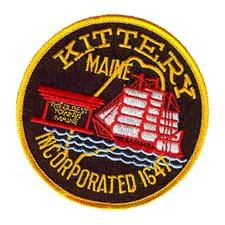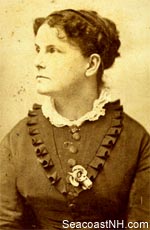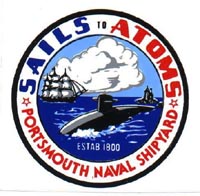| With Apologies to Kittery |

PORTSMOUTH PILFERS MAINE
If you took everything that happened in Kittery our of Portsmouth history – what would be left? Some politics, perhaps, and a few parades. Fact is, Portsmouth historians owe their Kittery neighbor a huge aology for appropriating their best stories. So here is that apology – 400 years in the making, and a summary of what we stole.
READ Where Kittery got its name
NOTE: The gist of this article was presented to the good citizens of Kittery by the author at a pot luck lunch for the Rice Public Library. See the new library guide to Kittery now in paperback.
DEAR KITTERY:
 On behalf of my fellow Portsmouth historians, living and deceased, I want to apologize to the town of Kittery. We have been stealing your stories for centuries. We’re not going to stop, of course, because too much of what we pretend happened here, really happened there. I just thought it would be nice to admit that we’re doing it on purpose.
On behalf of my fellow Portsmouth historians, living and deceased, I want to apologize to the town of Kittery. We have been stealing your stories for centuries. We’re not going to stop, of course, because too much of what we pretend happened here, really happened there. I just thought it would be nice to admit that we’re doing it on purpose.
The "Gateway to Maine" gets it from both sides. Mainers tend to toss off the state’s oldest official town as too intimately allied with New Hampshire while we are busy assimilating famous Kittery people and events. Most tourists, racing from one state to another, scarcely notice the town at all. To many, Kittery is little more than a bridge, a pit stop and a line of factory outlet stores on the way to somewhere else.
But for those who know it, Kittery is a rugged little hamlet with a unique mix of grit, charm and commercialism. It clings to the Piscataqua like a barnacle and has been adopted and adapted by fishermen, poets, shipyard workers and the summer gentry.
Here are just a few tidbits of Piscataqua history, Kittery-style:
FOUNDING DATES: Hovering between Canada and southern New England, Maine has a long rich Native American history. Its European occupation begins with French forts dating to the late 1500s. While Portsmouth and Dover battle over the founding date of 1623, Kittery takes the high road and promotes an official incorporation date of 1647. Yet like Portsmouth, the area was very active much earlier.
MASON & GORGES: It all started when English investors Mason and Gorges split their American land holdings in 1629 right up the Piscataqua River. Ferdinando Gorges got Maine, never made it pay, and his heirs sold the province to Puritans in the Bay Colony. Maine was part of Massachusetts until 1830.
 PEPPERRELL: Largely ignored by NH history, the dominant character in early Maine was William Pepperrell. Actually there were three William Pepperrells, the first of whom established the biggest fishing industry at the Isles of Shoals in the mid 1600s. One of the wealthiest landholders in the New World, Pepperrell's estate once stretched up the coast for 30 miles and included all of modern day Eliot and the Berwicks.
PEPPERRELL: Largely ignored by NH history, the dominant character in early Maine was William Pepperrell. Actually there were three William Pepperrells, the first of whom established the biggest fishing industry at the Isles of Shoals in the mid 1600s. One of the wealthiest landholders in the New World, Pepperrell's estate once stretched up the coast for 30 miles and included all of modern day Eliot and the Berwicks.
LOUISBOURG: The Pepperrell fishing industry was so vast that it felt cramped by competition from the French in Nova Scotia. In 1745, as colonel of the Massachusetts militia, son Sir William Pepperrell took 3,000 troops northward. With the help of the British fleet, he defeated the supposedly impregnable French fort of Louisbourg in Cape Bretton. He became the first native born American knighted by the king of England and was one of the wealthiest men in the New World.
INDIAN BATTLES: Kittery with its straggling shoreline of fishing huts actually suffered more damage from Indian reprisals in the late 1600s than Portsmouth. While 14 men women and children died on The Portsmouth Plains area, and three others nearby, Kittery suffered 88 deaths as Natives, goaded by the French, attacked and burned Kittery homes one by one.
WHIPPLE: William Whipple of Portsmouth, the New Hampshire man who signed the Declaration of Independence was born in Kittery in 1730.
PAUL JONES: John Paul Jones may have stayed in Portsmouth, but his 1777 ship Ranger was built at what is now Badger's Island in Kittery. Historians have suggested that, during the construction of Ranger, Jones may actually have stayed aboard ship in Maine. When he returned to Portsmouth in 1781, Jones supervised the launch of the ship of war America, then the largest ship ever built in the New World. It too was launched from Kittery. Kittery likely got the whole Piscataqua warship industry started in 1690 when "Yankee" colonials built and launched the HMS Falkland, the first major British ship built here.
CONTINUE KITTERY HISTORY
PORTSMOUTH STEALS KITTERY (continued)
 NAVY YARD: If the Piscataqua River was filled with ink, there wouldn't be enough of it to chronicle all the tales of the "Kittery Yard" which celebrated its bicentennial in the year 2000. In 1800 the newly hatched US Department of the Navy purchased Dennett's Island in Kittery to establish one of the country's first six federal shipyards. More islands on the Kittery site of the river were combined into the Portsmouth Naval Shipyard. Today 52 buildings at the yard are on the National Historic Register.
NAVY YARD: If the Piscataqua River was filled with ink, there wouldn't be enough of it to chronicle all the tales of the "Kittery Yard" which celebrated its bicentennial in the year 2000. In 1800 the newly hatched US Department of the Navy purchased Dennett's Island in Kittery to establish one of the country's first six federal shipyards. More islands on the Kittery site of the river were combined into the Portsmouth Naval Shipyard. Today 52 buildings at the yard are on the National Historic Register.
SUBS & SHIPS: Most of the warships and all of the submarines touted in Portsmouth history were built at Kittery. That includes the Kearsage, famed for its battle with the Confederate ship Alabama in the Civil War. That includes submarines Thresher, Squalus, Albacore and all the rest. "Portsmouth-built" is just another way of saying "Made in Kittery".
OLD IRONSIDES: Among the most famous ships repaired at Kittery Was the USS Constitution or "Old Ironsides" and one of the earliest photos in the Navy archives shows Ironsides under repair there in 1855. It remained as a tourist attraction, visible from Portsmouth, for more than a decade in the late 1800s.Immediately after the war of 1812, the commander of Old Ironsides, Isaac Hull took over as commander of the navy yard. Hull whipped the fledgling yard into shape.
FORTS: When we talk about the many forts that successfully warded off all enemies along the Piscataqua for three centuries, we note that half of them are in Maine. But the only reconstructed one, the hexagonal Fort McClary, stands proudly at Kittery Point, although it is named after a New Hampshire soldier.
HENDERSON'S POINT: And when we say that the biggest dynamite explosion on earth at thet time took place in Portsmouth Harbor in 1905, the spit of land blown up was Henderson’s Point in Kittery.
 TREATY OF PORTSMOUTH: Even the famed Treaty of Portsmouth ending the Russo-Japanese War in 1905 was signed in Kittery, not in Portsmouth. This event earned President Teddy Roosevelt the Nobel Prize, yet when Kittery citizens dared to suggest that the historic event might be called "The Treaty of Kittery", they were banned from the proceedings and mocked in the Portsmouth newspaper.
TREATY OF PORTSMOUTH: Even the famed Treaty of Portsmouth ending the Russo-Japanese War in 1905 was signed in Kittery, not in Portsmouth. This event earned President Teddy Roosevelt the Nobel Prize, yet when Kittery citizens dared to suggest that the historic event might be called "The Treaty of Kittery", they were banned from the proceedings and mocked in the Portsmouth newspaper.
VICTORIAN HOTELS: The Treaty delegates stayed at the Wentworth Hotel in New Castle, but in fact, Kittery had more than its share of Victorian tourist hotels -- now all gone. They included Hotel Parkfield (1887), the Pepperell House (1872) The Pocahontas on Gerrish Island (1880s), and the Champernowne (1890).
APPLEDORE: The most famous Victorian hotel in the region was on Appledore Island and operated by Thomas and Eliza Laighton and their children, Celia, Oscar and Cedric. Appledore Island, thanks to the Mason and Gorges property division, is technically part of Kittery.
CELIA THAXTER: Although poet Celia Thaxter was born in Portsmouth, she and her estranged husband Levi Thaxter owned land at Kittery Point. Levi and all three of their children – Karl, John and Roland – are buried at Kittery Point, between the historic Pepperrell House and the tomb of William Pepperrell.
SMUTTYNOSE: Smuttynose Island too Is part of Kittery, so all those stories about the 1873 murders retold in the book Weight of Water, are Kittery stories too. When killer Louis Wagner was apprehended and jailed at Portsmouth the following day, his lawyer pointed out that the heinous acts had been committed in Maine, not New Hampshire. Wagner was then jailed, tried, convicted and hanged in Maine.
ELECTRIC TRAINS; By the late 19th century, it was possible to take an electric trolley from Augusta, Maine all the way to New York City. There was only one spot in the entire journey where visitors had to leave the land and travel to another state by ferry. There was still no easy road between this Maine town and its rival city Portsmouth.
W D HOWELLS: The region’s tallest literary giant, William Dean Howells, editor of Atlantic Monthly and Harpers, promoted this region to visitors across the nation. He was a summer resident of Kittery Point.
STRAWBERY BANKE: And speaking of the Howells family, it was Muriel and John Meade Howells of Kittery who got the ball rolling on the creation of Strawbery Banke Museum prior to 1958. They had to overcome the fact that Portsmouth city officials were not originally interested in saving historic houses, when the requests came from foreigners who lived across the river in Kittery. Rosamund Thaxter of Kittery, Celia’s granddaughter, was among the first major contributors to the new Portsmouth museum.
I could go on, but why embarrass the Port City further? Portsmouth needs Kittery like Chang needs Eng. The cities are bound at the river’s edge, as separate and inseparable as Siamese twins that share the same flowing blood. Both cities were born from the same British investment group. New Hampshire got the short stick with 18 coastal miles. Maine boldly lists its coastal perimeter as just under 3,500 miles. It doesn’t take a therapy degree to understand why Portsmouth historians suffer from feelings of inadequacy and may, from time to time, stretch the truth a little.
(c) Copyright SeacoastNH.com
